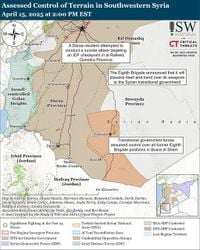On April 15, 2025, the Iran Update published by the Critical Threats Project (CTP) at the American Enterprise Institute and the Institute for the Study of War (ISW) provided a comprehensive overview of the current geopolitical landscape involving Iran and its regional activities. The report highlighted ongoing nuclear negotiations between Iran and the United States, internal developments within Iran, and the implications of these factors for regional stability.
Iranian Supreme Leader Ali Khamenei has recently indicated that engaging in nuclear negotiations with the U.S. might be crucial for preserving the stability of the Iranian regime. During a meeting with senior government officials on April 15, Khamenei emphasized the need to mitigate the impact of international sanctions on Iran's economy while also supporting nuclear talks. This shift in approach appears to be influenced by concerns over Iran's deteriorating economic conditions and potential internal unrest.
According to a report from The New York Times on April 11, key Iranian figures, including President Masoud Pezeshkian and Parliament Speaker Mohammad Bagher Ghalibaf, have convinced Khamenei to approve these nuclear talks to avoid the threat of a two-front war against both external military pressures and internal dissent.
The U.S. and Iran commenced nuclear discussions in Muscat, Oman, on April 12, 2025. However, there appears to be significant debate within the Trump administration regarding the direction of these talks. Unspecified sources briefed to the Wall Street Journal indicated that while the U.S. aims to address Iran's support for the Axis of Resistance, this topic was not discussed in the initial round of talks.
U.S. Special Envoy to the Middle East, Steve Witkoff, stated in an interview on April 14 that Iran does not need to enrich uranium beyond 3.67 percent. He further elaborated that any nuclear agreement must aim to halt and eliminate Iran's nuclear enrichment program. Iranian officials have expressed a willingness to revert to the uranium enrichment levels stipulated in the 2015 Joint Comprehensive Plan of Action (JCPOA), which limited Iran to 300 kilograms of uranium hexafluoride enriched to 3.67 percent.
As of now, Iran possesses 274.8 kilograms of uranium enriched to 60 percent, enough material to potentially produce around six nuclear weapons if further enriched. Witkoff also noted that negotiations would include discussions on verification regarding weaponization, which encompasses monitoring Iran's missile capabilities.
Notably, the missile restrictions outlined in United Nations Security Council Resolution 2231 expired in October 2023, raising concerns about Iran's missile program, which Tehran is unlikely to negotiate on as it is a key component of its regional deterrence strategy.
In Syria, the Eighth Brigade announced on April 13 that it would dissolve and surrender its arms to the Syrian transitional government amid increasing pressure. This decision is part of a broader effort by the transitional government to reduce the influence of the Eighth Brigade in southeastern Daraa, particularly following a violent incident involving its members.
Reports also indicate that Iran is allegedly collaborating with Sunni extremist groups in Syria, including ISIS, to destabilize the transitional government and facilitate smuggling operations. This cooperation follows the collapse of Iran's networks in Syria after the Assad regime's fall, suggesting an effort to reignite sectarian tensions in the region.
In Hasakah Province, northeastern Syria, a new group called the Free Hasakah Forces has emerged, threatening local tribal leaders who cooperate with the U.S.-backed Syrian Democratic Forces (SDF). This group's activities could undermine the SDF's influence in the area, particularly as they threaten to assassinate tribal leaders who do not distance themselves from the SDF.
Meanwhile, in Yemen, anti-Houthi factions are reportedly planning a ground offensive to reclaim the western coast, including Hudaydah Port. This operation necessitates coordination among fragmented anti-Houthi groups, with National Resistance Front leader Tariq Saleh meeting with Yemeni Defense Ministry officials to discuss collaboration.
On April 14, U.S. Central Command (CENTCOM) conducted at least 27 airstrikes targeting Houthi infrastructure, marking a significant escalation in military operations against the Houthis. These airstrikes are part of a broader strategy to weaken Houthi capabilities in the region.
In a related development, U.S. forces are expected to begin withdrawing from Syria by mid-June 2025, according to Israeli media sources. This withdrawal could present a vacuum that ISIS might exploit, potentially leading to a resurgence of the terrorist group in the region.
On April 15, Jordanian authorities arrested 16 individuals linked to the Muslim Brotherhood for planning rocket and drone attacks. Security services found a substantial cache of rockets and materials for producing additional munitions, although there is currently no evidence linking Iran to this incident. This development is noteworthy, especially as Iran has been increasingly focusing on Jordan in its regional strategy.
The Iranian rial has also experienced significant depreciation, falling from 879,000 rials to 890,000 rials per U.S. dollar within a day, reflecting the country's ongoing economic struggles.
In defense cooperation efforts, Iranian Defense Minister Brigadier General Aziz Nasir Zadeh met with Tajik Defense Minister Lieutenant General Emomali Sobirzoda to discuss enhancing collaboration in response to regional security threats.
The Iran Update serves as a vital resource for understanding the complex dynamics at play in the Middle East, particularly concerning Iran's nuclear ambitions, regional influence, and the ongoing conflicts in Syria and Yemen. As these developments unfold, the implications for U.S. foreign policy and regional stability remain critical.








